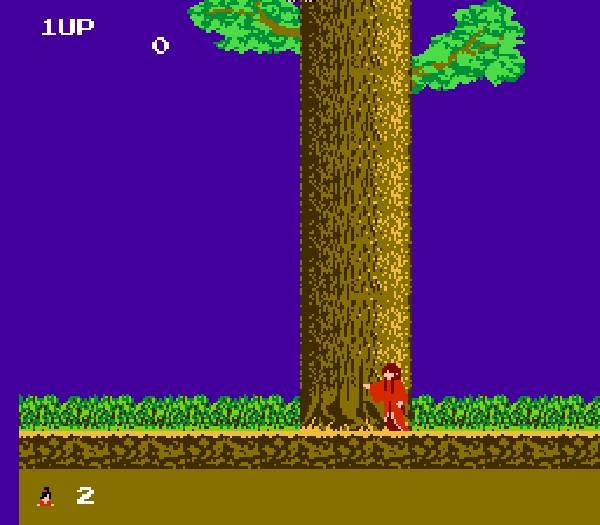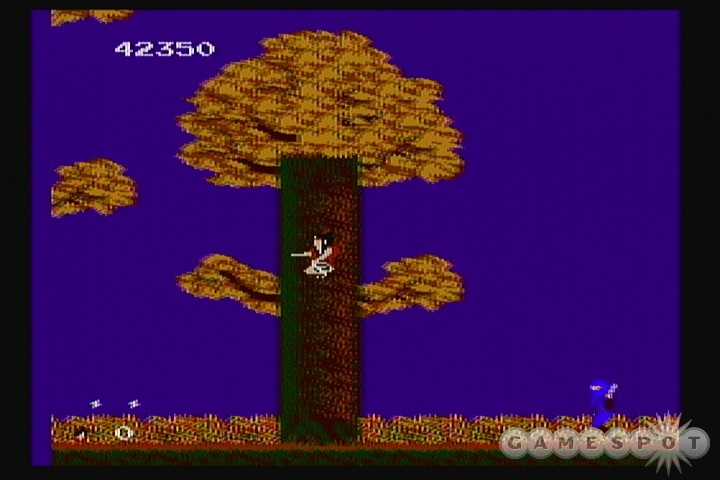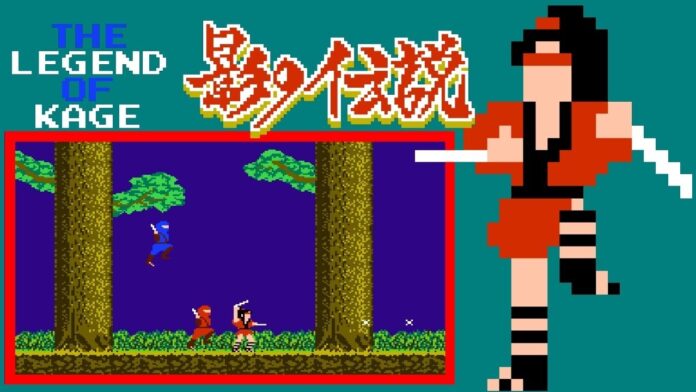
The Origins of The Legend of Kage
The Legend of Kage first appeared in Japanese arcades in 1985, before arriving in Europe and North America in 1986. Developed by Taito, one of the biggest game companies of the era, the project nearly got canceled during development. However, after strong feedback at a gaming expo, Taito decided to polish and release it.
The game quickly became a hit, with thousands of arcade cabinets sold worldwide. Its popularity led to ports across multiple platforms, including Famicom/NES, MSX, Amstrad CPC, Commodore 64, and ZX Spectrum. The Famicom version arrived in Japan in 1986, while the NES release came to North America in 1987. Decades later, the game was re-released on Wii Virtual Console, Nintendo 3DS, Wii U, and PS4 under the Arcade Archives label, proving its enduring appeal.
Story: A Ninja’s Quest to Save the Princess
The story of The Legend of Kage is simple yet effective—perfect for an arcade title. Players take on the role of Kage, a young ninja from the Iga clan, living during Japan’s late Edo period. His mission is to rescue Princess Kirihime, who has been kidnapped by warlord Yoshiro Kuyigusa and his samurai general Yukinosuke Riko.
The adventure unfolds across five stages: dense forests, hidden tunnels, fortress walls, and the enemy castle itself. Each time Kage rescues the princess, the season changes—from summer to autumn, then winter, before looping back to summer—creating a sense of endless struggle. If players fail, they must start over from the beginning. While simple, this narrative gave enough motivation to keep the action exciting.
Gameplay: Fast, Hard, and Addictive
The Legend of Kage is a 2D platformer with a focus on speed and agility. Players guide Kage using his trusty kodachi (short sword) and an infinite supply of shuriken to battle hordes of enemies. The objective is to survive five stages, each with its own challenge:
- Forest Stage: Run through trees, leap between branches, and fight ninja and flame-throwing monks. Defeat three Blue Monks to summon the powerful Red Monk.
- Tunnel Stage: Eliminate ten ninja, either by running through tunnels or swimming underwater. (Note: shuriken can’t be used while swimming.)
- Fortress Wall Stage: Climb to the top while dodging ambushing ninjas.
- Castle Stage: Scale four floors of the enemy castle, defeat enemies, and rescue the princess.
The NES version introduced crystal orbs as power-ups. Collecting one orb turned Kage’s outfit blue, granting larger shuriken. Two orbs changed his outfit to orange, giving him faster movement and higher jumps. If hit, Kage reverted to red, unless struck by fire, which killed him instantly.
What made the game notoriously difficult was its random enemy spawns and instant-death mechanics—one hit, and you’re gone. Points were awarded for defeating enemies and collecting orbs, encouraging mastery and precision.
Pro Tips:
- In the tunnel stage, defeating seven Blue Ninja with the sword grants a 1-UP.
- For 10 extra lives, hold a special button when resetting the NES game.
Ports, Sequels, and Remakes

While The Legend of Kage appeared on many systems, the NES version was the most widely played in the West. The Commodore 64 port received heavy criticism for poor graphics and sluggish performance. Meanwhile, the MSX and ZX Spectrum ports kept the spirit of the arcade game but were limited by hardware constraints.
In 2008, Taito released The Legend of Kage 2 on Nintendo DS, developed by Lancarse. This sequel kept the core gameplay but introduced new playable characters (Ayame and Ganin), an expanded story, and RPG-like elements such as a skill tree. Fans praised it for balancing difficulty with depth.
Other remakes included a 3D version on PSP (Taito Legends Power Up) and Revised Legend of Kage on PS2, which brought the game to a new generation.
Graphics and Music: Classic Japanese Style
Visually, The Legend of Kage reflected traditional Japanese aesthetics. Its lush forests, towering castles, and acrobatic ninjas created a striking atmosphere. The arcade version had vibrant colors, while the NES version was more stripped-down due to hardware limits.
The soundtrack, composed by Hisayoshi Ogura, leaned heavily into dramatic FM synth tones, capturing the spirit of a feudal Japan ninja adventure. The forest stage theme and boss battle music stood out for their intensity, adding urgency to the gameplay.
Reception: Loved and Hated
Upon release, The Legend of Kage was praised for its fast action and innovative gameplay, especially its vertical jumping mechanics. However, the NES port faced criticism for being too repetitive and brutally hard.
Modern reviewers are divided—some call it one of the worst NES games ever made, while others cherish it as a cult classic. On social media and retro gaming forums, players still share speedruns, strategies, and nostalgic memories, proving its lasting charm.
Legacy and Influence
Despite mixed reviews, The Legend of Kage carved out its place in gaming history. It inspired later ninja games like Ninja Gaiden, and even today, its DNA can be felt in modern retro-inspired titles. The game has appeared in pop culture, from fan mods to comedy reviews like Angry Video Game Nerd.
It may not be a perfect game, but it remains a symbol of the arcade era, celebrated for its speed, challenge, and unique ninja identity.
Walkthrough Snapshot
- Stage 1 (Forest): Move left, climb trees, defeat three Blue Monks, then face the Red Monk.
- Stage 2 (Tunnel): Defeat 10 ninja, use the sword underwater for quicker progress.
- Stage 3 (Fortress Wall): Scale to the top while dodging ambushing enemies.
- Stage 4-5 (Castle): Ascend four levels, defeat bosses, and rescue Princess Kirihime.
Tip: Use high jumps and shuriken to keep enemies at a distance. Keep moving—standing still is a recipe for defeat.
Conclusion
The Legend of Kage isn’t just a video game—it’s a piece of 1980s gaming history. With lightning-fast gameplay, a distinctly Japanese atmosphere, and punishing difficulty, it deserves its reputation as a legendary ninja adventure. Whether you’re a hardcore retro gamer or simply curious about arcade classics, The Legend of Kage is a must-play experience.

